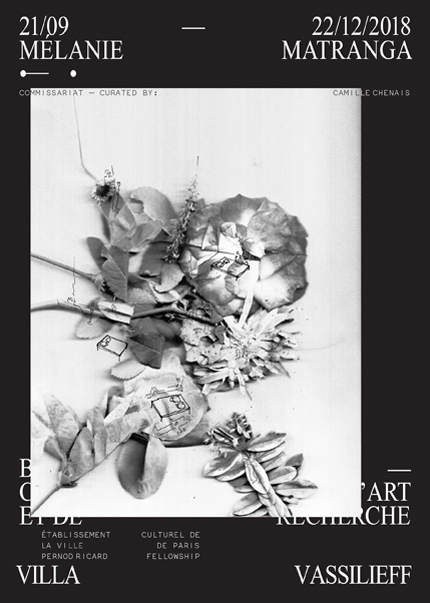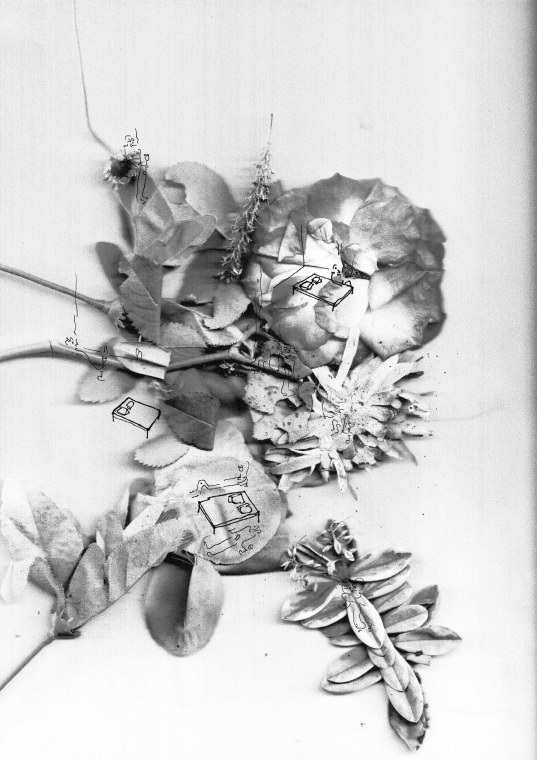Mélanie Matranga: •— •
Exhibition from 09.21 to 12.22.2018
Curated by Camille Chenais

- Flyer of the exhibition, Mélanie Matranga : •— •
Villa Vassilieff is pleased to present •— •, a solo exhibition of the french artist Mélanie Matranga (b. 1985).
Through this exhibition with a silent and unpronounceable title, Mélanie Matranga seizes Villa Vassilieff, in its charm and domesticity, to create a microcosm of objects, sensations, emotions and sounds. A sentimental and intimate white cube where white is no longer used as a neutral color, but as a material whose speci city seems to be its ability to get dirty, to both conceal and to ll itself with traces, residues and memories of gestures and moments that it welcomed. Here,the artist creates a living environment, where take place sculptures in paper and fabric that stem from common forms, almost generic. They are, for the most part, those of clothes made banal by their mass production and circulation. Through them and through sounds that leak from some of their pockets, the artist interrogate our communication systems : clothes, as words or music, are tools that allow us to introduce ourselves, to exchange with others, to translate our personalities and emotions.
•— •, by Camille Chenais
Through this exhibition with a silent and unpronounceable title, Mélanie Matranga seizes Villa Vassilieff, in its charm and domesticity, to create a microcosm of objects, sensations, emotions and sounds. A sentimental and intimate white cube where white is no longer used as a neutral color, but as a material whose specificity seems to be its ability to get dirty, to both conceal and to fill itself with traces, residues and memories of gestures and moments that it welcomed. If the environment is white, it is the opposite of the aseptic white cubes presumed to be neutral, timeless and erected as model by our institutions and the market. On the contrary, the space is presented as the result of past encounters and the receptacle for encounters to be lived. It oscillates between an apparent comfort and a discreet inhospitality. Behind what appears to be, at first glance, a bourgeois appearance, an uneasy being transpires through the pores of space, seeming to have seized the walls and floors. Something overflows and escapes from its own wrapping. Appearances crack, the space disintegrates. Like the skin, its surfaces become double-sided membranes - one turned to the outside world, the other turned to the inner world - that play the almost schizophrenic role of separating these two worlds while putting them in relation. But these interfaces seem dysfunctional, they no longer serve as filters and start showing on their surface some forms of internal and psychological scars.
Thus, Mélanie Matranga’s interventions in the space change its definition and the ways it can be perceived. Walls and floors no longer simply form its structure, but become organic elements that amplify and mimic feelings. Here the artist creates a living environment that changes and evolves, a setting where visitors’ bodies can be placed and wander. She does not only conceive space in its architectural aspect, but tries to take into account and be in touch with the people who will use it and, to some extent, activate it by their presence. By staging the almost overused domesticity of the place - with its library, counter bar, white tables and chairs - and by adding elements - green plants, white carpet - Mélanie Matranga highlights its artificiality and the tension that inhabits it, fluctuating between public space and falsely private interior. In this unique atmosphere, sculptures in paper and fabric take place; like many of her works, they stem from common forms, almost generic, that the artist transforms, solidifies or softens by reversing their materiality. The walls relax, the clothes stiffen.
The forms used are familiar. They are, for the most part, those of clothes made banal by their mass production and circulation. By dint of being produced, copied, counterfeited, repeated and imitated, these clothes seem to no longer have formal singularity. Mélanie Matranga has chosen them from her close and circumscribed universe and scrutinizes them to bring out what makes them common. These generic forms become peculiar through the treatment the artist puts them through; she transforms these garments lacking quality into somewhat ghostly white paper sculptures whose manufacturing seems instinctive, almost inaccurate. Through her manual work, these forms, normally produced in series, with industrial methods, seem to return to the prototype stage. Hypertrophied and swelling prototypes, practically failures, whose process of production is reflected in their seams. Like the space, these sculptures are white. On their surfaces and in their folds there are wrinkles and traces of sewing machine work, handling of parts, transport hazards or, simply, depending on when you visit the exhibition, marks of time and dust that have accumulated since their arrival at Villa Vassilieff. What does not appear in the space are the bodies, the people who normally wear these clothes. No human presence is visible in the exhibition, with the exception of the visitors. Apart from the windows through which a natural and continuously changing light escapes, the only sources of light are the sculptures themselves, which recurrently house a bulb whose rays pierce the semi-opaque paper. They are diffused in the space and become the binding element between the different components of the decor put in place by Mélanie Matranga. Somehow, these lights also appear as allegories of the bodies that normally inhabit these clothes and the way in which, through them, we try to express our interiority which can shine through at varying degrees. Our clothes are codes that we use to display a certain personality, a social role, a staging of oneself, to disappear or to appear. Those here transformed by the artist are popular and recognizable. Even though they form a reference linked to a given time and place - today, Paris - they still have many places of appearance and diffusion between the moment of their creation and the one of their dissolution. In a way, we all share these clothes, which become structures of a collective intimacy as well as the signs of a nonverbal but very loquacious communication system that confesses our individual, collective, sexual and social identities. Words, like clothes, are tools that allow us to introduce ourselves, to exchange with others, to translate our personalities and emotions. But these signs - words and clothes - are also designed and controlled by bodies that transcend us - a culture, a state, an economic system, a production network, or a community. Our intimacies are therefore diluted in these codes which, to be efficient, must be generic and comprehensible. In the exhibition space, clothes become allegories of the words we employ to represent things and our feelings in what makes them most ordinary. When we say «I», «LOVE», «HATE», all the specific characteristics and thousand of nuances that our feelings seem to have in our consciousness are hidden from ourselves.
Mélanie Matranga plays with the limits of our communication systems. She tries to muddle them or to find, naively or desperately, an exit by way of their constraints. She is interested in how our bodies and personalities try to thwart these limits, sometimes naively, sometimes fortuitously and in the tension that results. Our skin, like the surfaces of the space, sweats, blushes, and is covered with signs of our sometimes stifled emotions. If the clothes are empty, some of them allow an inner glow to escape, translating, perhaps, as a possibility to let their «I» shine through. In these works, the idea is not to build a new logical and rational semiotic system, but to express in the same movement the complexity and simplicity of our methodologies and communication strategies. Express without affirming. Nothing asserts itself in the space, nothing is held straight, nothing is truly rigid, nothing stands upright; things hang, things are placed, things are suspended. In the very construction of space, the artist seems to refuse the certainties, the declarations; she whispers, suggests. Like the fabric sculptures that create undefined flexible spaces, the title of the exhibition refuses any rigidity or encapsulation of bodies and speeches. Simply symbol, initially drawn by the artist on a piece of paper, it translates to, in a very prosaic way, two points that do not arrive / are not / do not wish to be connected to each other via a line. This sign is in motion and declines according to the written media and its limits - computer keyboards, for example, have difficulties in reproducing this form first sketched by the artist in pencil. Deliberately equivocal, this title, the space of the exhibition and the sculptures that take place there form emotional structures which leave room for the visitors to project and to look for the trace of their own sensitivity.

Partager